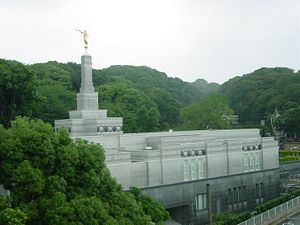In January, the Church of Jesus Christ of Latter-day Saints (better known as the Mormon Church) received official permission to open a mission in the Democratic Republic of Vietnam. Previously, the Church had run its Vietnam operations out of Phnom Penh, Cambodia.
The LDS Church views itself as having a special evangelical mission, and has supported expansion abroad (and within the United States) to an extent greater even than mainstream evangelical protestant congregations. And LDS has long pursued inroads into East Asia. The first Mormon missionaries arrived in Asia in the 1850s (to little effect), and a community developed in Japan in the early part of the 20th century. LDS really began to grow in Asia in the second half of the twentieth century, however, as the reach of the U.S. economy and the permanent stationing of the U.S. military meant that LDS missionaries would have continual access to potential converts. Mormons are well represented in the U.S. military, government, and intelligence service, in part because of the Church’s focus on language skills and service abroad.
The Church’s biggest successes in Asia have come in the Philippines (730,000 adherents, .72 percent of the population), and (strangely enough) in Mongolia (11,000 Mormons, .38 percent of the population). In South Korea, LDS has rode the same wave as other evangelical Christian churches, making up roughly 1 percent of Korea’s 8.6 million Protestants. Japan also has a substantial LDS community.
China marks the next big frontier. The Church made abortive efforts to establish a presence in 1853, and again in 1921, but has never taken hold. The PRC does not treat the LDS Church as a cult, but it does maintain restrictions on its extent and spread. The LDS cannot officially proselytize in the PRC, although individual congregants can worship. The hierarchical structure of the Church makes the development of “secret,” or unofficial congregations difficult and unlikely, and the Church has made clear that it will obey and respect Chinese law. However, the Church remains active in Hong Kong, and in Taiwan, where it has seen significant success. It’s also worth noting that President Obama appointed LDS member (and former Utah governor) John Huntsman Jr. as his first ambassador to China.
Strong commercial and social relations between the United States and China obviously benefit LDS. U.S. expatriates, and Chinese nationals who convert in the United States and return to China, will serve to expand existing Church attendance in China, even in the absence of the development of official missions. But security tension (especially insofar as it drives popular and official hostility towards the United States) obviously does not help the LDS. This is especially true given the long, difficult relationship between various Chinese governments and various kinds of Western missionaries.
In some sense, thus, the future of LDS in Asia depends upon the future of the United States in Asia. The Church has grown as U.S. power and reach in the region have expanded. The increasing power of the PRC, and its complex relationship with the United States, represents a challenge for the Church, but perhaps also an opportunity.
































